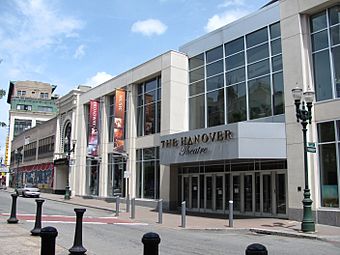- This page was last modified on 9 August 2025, at 07:10. Suggest an edit.
Hanover Theatre & Conservancy for the Performing Arts facts for kids
|
The Hanover Theatre, The Hanover Theatre and Conservatory, The Hanover Theatre Conservatory
|
|

Hanover Theatre & Conservatory for the Performing Arts, main entrance near camera, original entrance in distance (near car)
|
|
| Address | 2 Southbridge Street Worcester, Massachusetts United States |
|---|---|
| Owner | Worcester Center for Performing Arts |
| Capacity | 2,300 |
| Current use | Touring acts |
| Construction | |
| Opened | Franklin Square Theatre 1904 The Grand 1926 |
| Rebuilt | 2008 |
| Architect | Cutting, Carleton & Cutting; Thomas W. Lamb |
| Website | |
|
Poli's Palace Theater
|
|
| Lua error in Module:Location_map at line 420: attempt to index field 'wikibase' (a nil value). | |
| Location | Worcester, MA |
| Built | 1902–1904 |
| Architect | Cutting, Carleton & Cutting; Thomas W. Lamb |
| Architectural style | Renaissance |
| NRHP reference No. | 10001122 |
| Added to NRHP | January 10, 2011 |
The Hanover Theatre and Conservatory for the Performing Arts is a special place in Worcester, Massachusetts. It has a large hall where many different shows perform. It also has classrooms for learning about the arts.
This theatre first opened in 1904. It was called the Franklin Square Theatre back then. It showed live variety acts and big Broadway shows. By 1912, it started showing silent films. This happened after a theatre owner named Sylvester Poli bought it.
Contents
The Theatre's Early Days
The Franklin Square Theatre was designed in 1902. A local company called Cutting, Carleton & Cutting created its plans. A well-known real estate developer, Ramsom C. Taylor, asked them to build it.
Changes and New Names
After Sylvester Poli bought the theatre, he made many changes. He renamed it The Grand. It continued to show silent movies. In 1926, Poli hired a famous theatre designer, Thomas W. Lamb. Lamb made the theatre much bigger. Its seating could hold 3,500 people.
The building became a fancy showplace. It had a two-story lobby with mirrored walls. There were also marble-like columns and a grand staircase. A huge chandelier hung in the main hall. All these changes were ready just as movies with sound, called talkies, began in 1927.
New Owners Over Time
In 1928, Poli sold his theatres to William Fox. Fox then changed the theatre's name to the Loew's Poli. Later, in 1967, Sumner Redstone and Redstone Theaters bought the building. They opened it as Showcase Cinemas. It worked as a movie theatre with many screens until 1998. That's when Redstone's company, National Amusements, closed it.
In 2002, National Amusements gave the theatre to a non-profit group. This group was called the Worcester Center for the Performing Arts. Ed Madaus and Paul Demoga started it.
Reopening as The Hanover Theatre
After a lot of fundraising and community support, the theatre reopened in March 2008. It was named The Hanover Theatre for the Performing Arts. This name came from one of its main sponsors, Hanover Insurance. They gave a lot of money to help the theatre open again.
Today, the theatre can seat 2,300 people. It hosts famous entertainers and big Broadway shows. It also provides a place for local artists to perform. The Franklin Square Salon Gallery is on the second floor. It shows art exhibits organized by ArtsWorcester.
The theatre was added to the National Register of Historic Places in January 2011. It was listed under the name Poli's Palace Theater.
The Conservatory for Learning
The Hanover Theatre Conservatory for the Performing Arts was added in 2016. This part of the theatre is for education. It has classrooms for acting and singing lessons. Students can also learn about theatre production. This includes lighting, costume design, and set design. It also has special bars for ballet and dance training.


